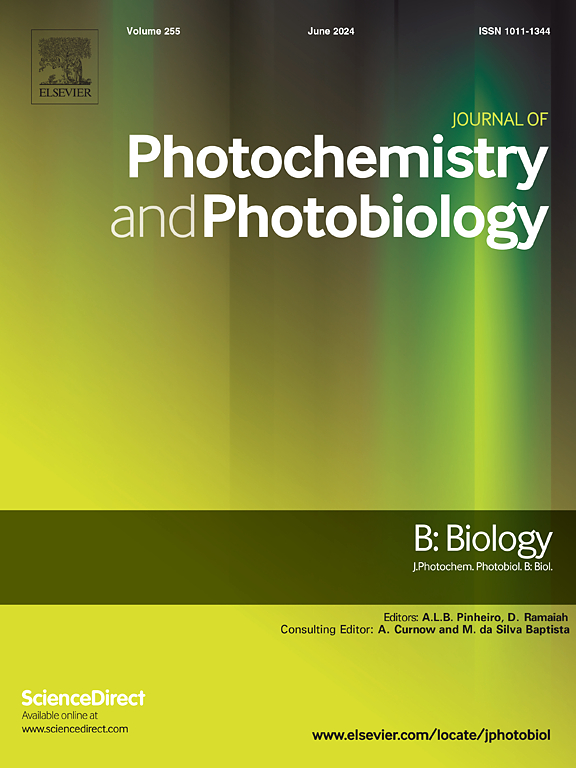近红外光治疗使阿尔茨海默病的淀粉样蛋白负荷、神经元脂膜秩序、筏和胆固醇水平正常化。
IF 3.9
2区 生物学
Q2 BIOCHEMISTRY & MOLECULAR BIOLOGY
Journal of photochemistry and photobiology. B, Biology
Pub Date : 2025-01-01
DOI:10.1016/j.jphotobiol.2024.113086
引用次数: 0
摘要
胆固醇失调、神经元膜脂质堆积紊乱和脂筏导致有毒淀粉样蛋白-β (Aβ)的合成和积累,有助于阿尔茨海默病(AD)的发展。我们的研究表明,近红外(NIR)经颅光生物调节治疗(tPBMT)可以减少Aβ负荷并恢复AD期间神经元质膜的特性,包括Aβ生成,双层秩序,筏,脂质含量和Ca2+通道。实验小鼠每天暴露在808纳米LED下1小时,持续3个月。在APOE转基因胆固醇失调模型中,胆固醇水平增加了22倍,导致健康神经元产生毒性Aβ的速度加快了3倍,其负荷增加了5倍。因此,Aβ破坏膜双分子层,促进脂筏和毛孔的形成。NIR-tPBMT可以减少近一半的Aβ负荷,恢复膜脂的秩序和刚性,减少脂筏的数量,调节胆固醇合成,通过激活内吞作用使Ca2+内流正常化,并减少神经元死亡。光诱导的Ca2+内流不会引起兴奋性毒性,但会调节参与AD机制和细胞活力的Ca2+/钙调蛋白信号。脑皮层和海马的转录组分析显示,光可以下调Ca2+/钙调素依赖性ad风险基因BACE、PSEN和APP,并通过HMGCR、DHCR7和INSIG1基因使胆固醇稳态正常化。此外,光通过激活未折叠蛋白反应的转录因子增强了神经元对内质网应激的抵抗力。因此,红/近红外光可能在对抗阿尔茨海默病、恢复退化神经元突触可塑性和减少Aβ负荷方面有希望。本文章由计算机程序翻译,如有差异,请以英文原文为准。

Near-infrared light therapy normalizes amyloid load, neuronal lipid membrane order, rafts and cholesterol level in Alzheimer's disease
Cholesterol dysregulation, disorder of neuronal membrane lipid packing, and lipid rafts lead to the synthesis and accumulation of toxic amyloid-β (Aβ), contributing to the development of Alzheimer's disease (AD). Our study shows that near-infrared (NIR) transcranial photobiomodulation therapy (tPBMT) can reduce Aβ load and restore the properties of neuronal plasma membrane, including Aβ production, bilayer order, rafts, lipid content, and Ca2+ channels during AD. Mice in the experiments were exposed to 808-nm LED for 1 h daily over 3 months. In the APOE transgenic model with cholesterol dysregulation, the cholesterol levels increased by 22 times, causing healthy neurons to produce toxic Aβ three times faster, increasing its load by five times. Consequently, Aβ disrupts the membrane bilayer and prompts the formation of lipid rafts and pores. NIR-tPBMT can nearly half attenuate Aβ load, restore membrane lipid order and rigidity, reduce the number of lipid rafts, modulate cholesterol synthesis, normalize Ca2+ influx by activated endocytosis, and reduce neuronal death. The Ca2+ influx induced by light does not cause excitotoxicity but modulates Ca2+/calmodulin signaling involved in AD mechanisms and cell viability. The transcriptome analysis of the brain cortex and hippocampus shows that light can downregulate Ca2+/calmodulin-dependent AD-risk genes BACE, PSEN, and APP, and normalize cholesterol homeostasis via the HMGCR, DHCR7, and INSIG1 genes. Additionally, light enhances neuron resistance to the endoplasmic reticulum stress via activating transcription factors of the unfolded protein response. Thus, red/NIR light could be promising in combating AD, restoring synaptic plasticity in degenerating neurons and reducing Aβ load.
求助全文
通过发布文献求助,成功后即可免费获取论文全文。
去求助
来源期刊
CiteScore
12.10
自引率
1.90%
发文量
161
审稿时长
37 days
期刊介绍:
The Journal of Photochemistry and Photobiology B: Biology provides a forum for the publication of papers relating to the various aspects of photobiology, as well as a means for communication in this multidisciplinary field.
The scope includes:
- Bioluminescence
- Chronobiology
- DNA repair
- Environmental photobiology
- Nanotechnology in photobiology
- Photocarcinogenesis
- Photochemistry of biomolecules
- Photodynamic therapy
- Photomedicine
- Photomorphogenesis
- Photomovement
- Photoreception
- Photosensitization
- Photosynthesis
- Phototechnology
- Spectroscopy of biological systems
- UV and visible radiation effects and vision.

 求助内容:
求助内容: 应助结果提醒方式:
应助结果提醒方式:


